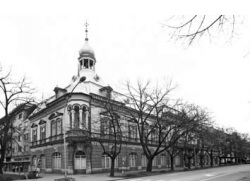The building was erected in 1909 according to the projects of architect BERENZENCZEY DOMONKOS, who designed the building of the Gymnasium in Senta. The building contractor was SZÁRICH GEZA elected in 1908 at the time of the GOZON ISTVÁNA pleban. Plebania’s premises were designed on the first floor, while the ground floor was intended for commercial space. In 1911, the church “St. István “, half of the ground floor (left wing) has been converted into a chapel that is still today, and the right wing from the central portal was shops and printing houses until 1971, when the Museum is moved into that space and occupies the rooms on the floor of the right wing.
Although designed at the end of the first decade of the twentieth century, and probably at the order of the orderer and the affinity of the architect, the building contains all the stylistic elements of historicism, or closer neo-baroque, tendencies in the architecture of the past century, but very re-indicative dimensions for the concepts of the Saints of that time.
The exterior facade is fully preserved, and only the left wing of the roof is altered, but in the same material (eternity), while the roof holes (badges) are made as a few copies of the primers in the sheet. At the point of collision of two wings (corner) there is an extremely representative whole, from the base to the roof part. From the parapet are placed to the left and to the right of the large, arched windows, the two half-holes on which are located Athlete carrying the pentagonal base with a relief relief, on each surface there is a relief in the stump solved half-pasta margarita. The balcony is overdue with a shallow dome, a canopy of arcades with Corinth capitals. Baldachin is covered with tin kalot, with a gilded cross on the top. Above the balcony above the decked roof, the dome of a four-legged base is covered with a sheet, with a lantern.
On the central facade, which is longer than the lateral, the entrance portal is made in combination of wood and iron, and to the left and right are the atlantes in rich girlanded decorated semi-lobbies, which carry the central part of the large balcony with a balustrade, while the side consoles are in the form of an angelic head ). The façade area of the balcony is richly decorated. Three doors with pilasters that carry a window arch and the façade is divided into four corinthian pillars (semi-slabs) that carry the roof parapet. This ensemble closes with an infant in the form of a balustrade. The horizontal partitioning of the façade was done with a highly profiled first floor and the roof umbrella. Roof construction over a rectangular balcony, it is resolved in the form of a rectangular tent roof, while the central part interrupts the attic window with tympanum, placed in the field.This type of window alternates between the roof and the circular ceilings of the sheet metal.
The side rhizalites are covered with rustics that flows through the entire terrestrial part, and the windows above are trimmed over the cornice with three Ion halves with balustrades, and the semi-lobes carry a parapet with a broken tympanum with an angel in the center.
The surface of the groundwork is covered with rustics and the façade is dotted with an alternate array of large arched windows (expositions) above the socle, which are only decorated with blind brackets in the shape of the heads of Greek warriors over the central part of the port.
The interior, the area of the chapel and the museum rooms has been changed today and adapted to the new purpose. In the original condition there was a staircase with a whitish balustrade of wrought iron. The decoration is in the spirit of the Neo-Baroque with the easy influence of the secession line.
PARISH AND THE MUSEUM


0 comments on “PARISH AND THE MUSEUM”